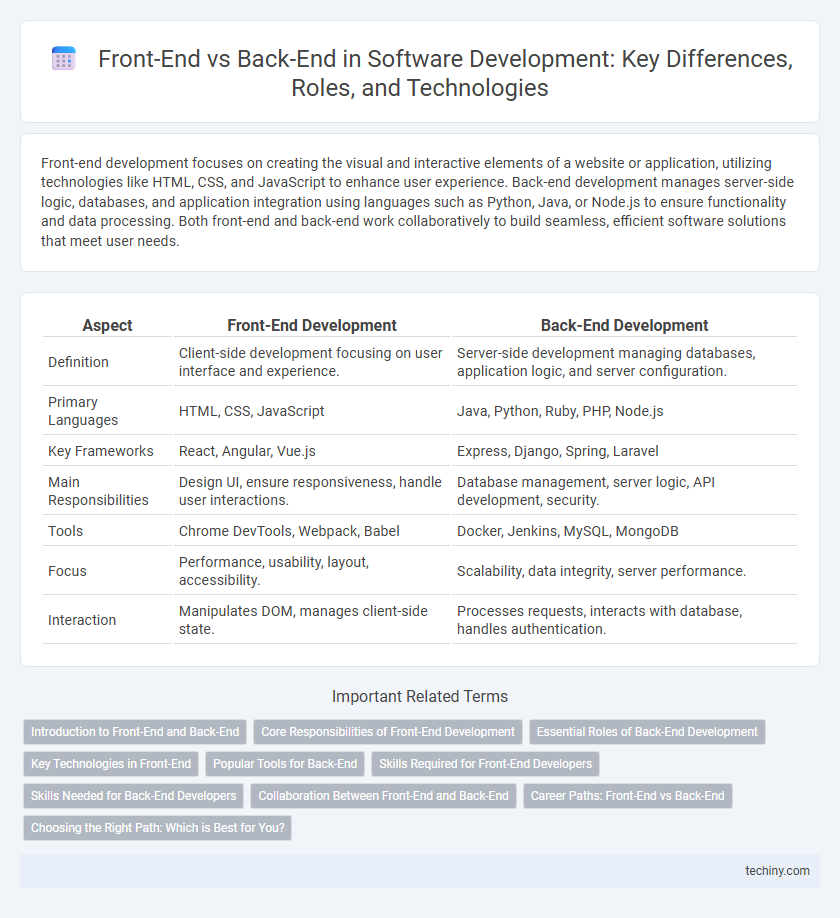Front-end development focuses on creating the visual and interactive elements of a website or application, utilizing technologies like HTML, CSS, and JavaScript to enhance user experience. Back-end development manages server-side logic, databases, and application integration using languages such as Python, Java, or Node.js to ensure functionality and data processing. Both front-end and back-end work collaboratively to build seamless, efficient software solutions that meet user needs.
Table of Comparison
| Aspect | Front-End Development | Back-End Development |
|---|---|---|
| Definition | Client-side development focusing on user interface and experience. | Server-side development managing databases, application logic, and server configuration. |
| Primary Languages | HTML, CSS, JavaScript | Java, Python, Ruby, PHP, Node.js |
| Key Frameworks | React, Angular, Vue.js | Express, Django, Spring, Laravel |
| Main Responsibilities | Design UI, ensure responsiveness, handle user interactions. | Database management, server logic, API development, security. |
| Tools | Chrome DevTools, Webpack, Babel | Docker, Jenkins, MySQL, MongoDB |
| Focus | Performance, usability, layout, accessibility. | Scalability, data integrity, server performance. |
| Interaction | Manipulates DOM, manages client-side state. | Processes requests, interacts with database, handles authentication. |
Introduction to Front-End and Back-End
Front-End development focuses on designing and implementing the user interface of web applications using technologies like HTML, CSS, and JavaScript, ensuring an interactive and responsive user experience. Back-End development involves managing server-side logic, databases, and application functionality through programming languages such as Python, Java, or Node.js, enabling data processing and business logic execution. Together, Front-End and Back-End development form the full stack that powers modern web applications.
Core Responsibilities of Front-End Development
Front-end development centers on creating the visual and interactive elements of a website or application using HTML, CSS, and JavaScript, ensuring an intuitive user experience. Developers implement responsive designs to guarantee functionality across diverse devices and browsers while optimizing load times and accessibility. Key tools and frameworks include React, Angular, and Vue.js, which facilitate efficient UI component management and state handling.
Essential Roles of Back-End Development
Back-end development is essential for managing server-side logic, database interactions, and application architecture. It ensures data integrity, security, and seamless communication between the front-end interface and server resources. Key technologies include server languages like Python, Java, or Node.js, along with databases such as MySQL, MongoDB, or PostgreSQL.
Key Technologies in Front-End
Front-end development primarily relies on HTML5, CSS3, and JavaScript to create interactive and responsive user interfaces. Popular frameworks and libraries such as React, Angular, and Vue.js enhance development efficiency and user experience by enabling component-based architecture and dynamic rendering. Tools like Webpack and Babel optimize code performance and compatibility across different browsers, ensuring seamless front-end operation.
Popular Tools for Back-End
Popular tools for back-end development include frameworks like Node.js, Django, and Ruby on Rails, which streamline server-side coding and database management. Databases such as MySQL, PostgreSQL, and MongoDB are essential for data storage and retrieval in back-end systems. Cloud platforms like AWS, Azure, and Google Cloud provide scalable infrastructure, enabling efficient deployment and management of back-end applications.
Skills Required for Front-End Developers
Front-end developers must master HTML, CSS, and JavaScript to create responsive and dynamic user interfaces. Proficiency in frameworks such as React, Angular, or Vue.js enhances their ability to build seamless single-page applications. Strong skills in UI/UX design principles, cross-browser compatibility, and version control systems like Git are also essential for optimizing user experience and maintaining code quality.
Skills Needed for Back-End Developers
Back-end developers require strong expertise in server-side programming languages such as Java, Python, Ruby, or Node.js, along with proficiency in database management systems like MySQL, PostgreSQL, or MongoDB. Mastery in API development, server architecture, and security protocols is essential to ensure efficient data processing and seamless communication between front-end and back-end components. A solid understanding of cloud services, version control systems like Git, and performance optimization techniques significantly enhances a back-end developer's ability to build scalable and reliable applications.
Collaboration Between Front-End and Back-End
Effective collaboration between front-end and back-end teams enhances the seamless integration of user interfaces with server-side logic, ensuring a cohesive user experience. Utilizing APIs, clear documentation, and regular communication streamlines data exchange, reduces development time, and minimizes debugging issues. Leveraging tools like version control systems and agile methodologies further synchronizes workflows, optimizing productivity and product quality.
Career Paths: Front-End vs Back-End
Front-End developers specialize in creating user interfaces and improving user experience, utilizing technologies like HTML, CSS, and JavaScript frameworks such as React or Angular, which makes their career path ideal for those passionate about design and usability. Back-End developers focus on server-side logic, database management, and API integration, working primarily with languages like Python, Java, or Node.js, making it a suitable path for individuals interested in system architecture and data processing. Both career paths offer opportunities to advance into full-stack development, project leadership, or specialized roles in cloud services and cybersecurity.
Choosing the Right Path: Which is Best for You?
Front-end development centers on crafting intuitive user interfaces with technologies like HTML, CSS, and JavaScript, ideal for those passionate about design and user experience. Back-end development involves server-side logic, databases, and APIs using languages such as Python, Java, or Node.js, suited for individuals interested in data management and system architecture. Evaluating your strengths in creativity versus logical problem-solving helps determine whether front-end or back-end specialization aligns best with your career goals.
Front-End vs Back-End Infographic

 techiny.com
techiny.com